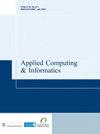Robust dual-tone multi-frequency tone detection using k-nearest neighbour classifier for a noisy environment
IF 4.9
Q1 COMPUTER SCIENCE, INFORMATION SYSTEMS
引用次数: 1
Abstract
Purpose Due to the continuous and rapid evolution of telecommunication equipment, the demand for more efficient and noise-robust detection of dual-tone multi-frequency (DTMF) signals is most significant. Design/methodology/approach A novel machine learning-based approach to detect DTMF tones affected by noise, frequency and time variations by employing the k-nearest neighbour (KNN) algorithm is proposed. The features required for training the proposed KNN classifier are extracted using Goertzel's algorithm that estimates the absolute discrete Fourier transform (DFT) coefficient values for the fundamental DTMF frequencies with or without considering their second harmonic frequencies. The proposed KNN classifier model is configured in four different manners which differ in being trained with or without augmented data, as well as, with or without the inclusion of second harmonic frequency DFT coefficient values as features. Findings It is found that the model which is trained using the augmented data set and additionally includes the absolute DFT values of the second harmonic frequency values for the eight fundamental DTMF frequencies as the features, achieved the best performance with a macro classification F1 score of 0.980835, a five-fold stratified cross-validation accuracy of 98.47% and test data set detection accuracy of 98.1053%. Originality/value The generated DTMF signal has been classified and detected using the proposed KNN classifier which utilizes the DFT coefficient along with second harmonic frequencies for better classification. Additionally, the proposed KNN classifier has been compared with existing models to ascertain its superiority and proclaim its state-of-the-art performance.基于k近邻分类器的噪声环境下的鲁棒双音多频检测
目的由于电信设备的不断快速发展,对双音多频(DTMF)信号进行更高效和抗噪声检测的需求最为显著。设计/方法/方法提出了一种新的基于机器学习的方法,通过使用k近邻(KNN)算法来检测受噪声、频率和时间变化影响的DTMF音调。使用Goertzel算法提取训练所提出的KNN分类器所需的特征,该算法估计基本DTMF频率的绝对离散傅立叶变换(DFT)系数值,无论是否考虑其二次谐波频率。所提出的KNN分类器模型以四种不同的方式配置,这四种方式在使用或不使用增强数据以及使用或不包括二次谐波频率DFT系数值作为特征进行训练方面有所不同。发现使用增广数据集训练并另外包括八个基本DTMF频率的二次谐波频率值的绝对DFT值作为特征的模型以0.980835的宏分类F1得分获得了最佳性能,五倍分层交叉验证精度为98.47%,测试数据集检测精度为98.1053%。原始性/值使用所提出的KNN分类器对生成的DTMF信号进行分类和检测,该分类器利用DFT系数和二次谐波频率进行更好的分类。此外,将所提出的KNN分类器与现有模型进行了比较,以确定其优越性并宣布其最先进的性能。
本文章由计算机程序翻译,如有差异,请以英文原文为准。
求助全文
约1分钟内获得全文
求助全文
来源期刊

Applied Computing and Informatics
Computer Science-Information Systems
CiteScore
12.20
自引率
0.00%
发文量
0
审稿时长
39 weeks
期刊介绍:
Applied Computing and Informatics aims to be timely in disseminating leading-edge knowledge to researchers, practitioners and academics whose interest is in the latest developments in applied computing and information systems concepts, strategies, practices, tools and technologies. In particular, the journal encourages research studies that have significant contributions to make to the continuous development and improvement of IT practices in the Kingdom of Saudi Arabia and other countries. By doing so, the journal attempts to bridge the gap between the academic and industrial community, and therefore, welcomes theoretically grounded, methodologically sound research studies that address various IT-related problems and innovations of an applied nature. The journal will serve as a forum for practitioners, researchers, managers and IT policy makers to share their knowledge and experience in the design, development, implementation, management and evaluation of various IT applications. Contributions may deal with, but are not limited to: • Internet and E-Commerce Architecture, Infrastructure, Models, Deployment Strategies and Methodologies. • E-Business and E-Government Adoption. • Mobile Commerce and their Applications. • Applied Telecommunication Networks. • Software Engineering Approaches, Methodologies, Techniques, and Tools. • Applied Data Mining and Warehousing. • Information Strategic Planning and Recourse Management. • Applied Wireless Computing. • Enterprise Resource Planning Systems. • IT Education. • Societal, Cultural, and Ethical Issues of IT. • Policy, Legal and Global Issues of IT. • Enterprise Database Technology.
 求助内容:
求助内容: 应助结果提醒方式:
应助结果提醒方式:


